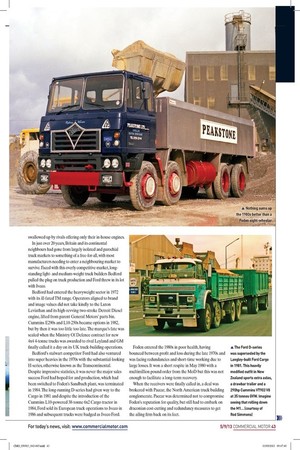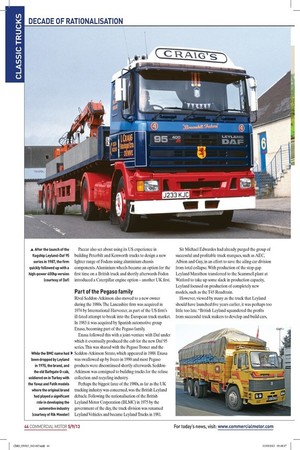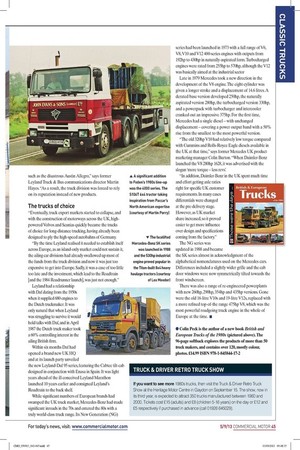in the r CM looks at how the 1980s ushered
Page 34

Page 35

Page 36

Page 37

If you've noticed an error in this article please click here to report it so we can fix it.
in a decade of company rationalisation Words: Colin Peck / Images sourced by: Colin Peck
While the 1970s might have been defined as the decade of change, the 1980s turned out to be the decade of rationalisation. Few could have predicted that of the more than 60 British and European truck manufacturers that existed at the beginning of the 1970s, only 44 would still be in business in 1980. That number was reduced even further in the following 10 years, due to amalgamations and acquisitions on a major scale.
British truck manufacturers were hardest hit, with just 11 of the 18 firms in business at the start of the 1970s still bashing metal in 1980. AEC, Albion, Guy and Thornycroft all fell victim to the British Leyland axe as it strived to prop up the ailing car empire, and it wasn't long before Scammell also went to the chop. Commer had gone and the Dodge brand was on its last legs, while Dublin-based Dennison was history within 12 months of the new decade.
Despite much hoo-ha during the 1970s about increased vehicle weights potentially bringing Britain closer to harmonisation with European trucking legislation, it was not until the government White Paper of 1982— setting out plans for 32 tonnes on four axles, 38 tonnes on five axles and 44 tonnes on six axles — that truck manufacturers and operators had something tangible to deal with.
While operators evaluated how equipment designed for higher gross weights would benefit their operational capabilities and profit margins, many truck manufacturers took a long hard look at the spiralling costs of developing and building new models in the face of tough and ever-increasing competition. Seddon-Atkinson was already in foreign ownership and
Foden was acquired in 1980 by US truck manufacturing giant Paccar. Across the Channel, Ban-eiros, Berliet, Bussing, Hanomag-Henschel and Saviem had already been swallowed up by major brands, while Fiat, Magirus-Deutz, OM and Unic had morphed into Iveco. The 1980s witnessed something akin to a feeding frenzy as specialist builders and major firms were snapped up by rivals. A race for power The increase in gross vehicle weights saw manufacturers enter something of a power race, with multi-cylinder turbocharged and intercooled diesels of 300hp and even 400hp becoming ever popular. The decade also witnessed the decline of proprietary diesels as truck builders that had previously installed plants such as Cummins, Detroit Diesel, Deutz, Gardner, Perkins and Rolls-Royce were
swallowed up by rivals offering only their in-house engines.
In just over 20 years, Britain and its continental neighbours had gone from largely isolated and parochial truck markets to something of a free-for-all, with most manufacturers needing to enter a neighbouring market to survive. Faced with this overly competitive market, longstanding lightand medium-weight truck builders Bedford pulled the plug on truck production and Ford threw in its lot with Iveco.
Bedford had entered the heavyweight sector in 1972 with its ill-fated TM range. Operators aligned to brand and image values did not take kindly to the Luton Leviathan and its high-revving two-stroke Detroit Diesel engine, lifted from parent General Motors' parts bin. Cummins E290s and L10-250s became options in 1982, but by then it was too little too late. The marque's fate was sealed when the Ministry Of Defence contract for new 4x4 4-tonne trucks was awarded to rival Leyland and GM finally called it a day on its UK truck-building operations.
Bedford's stalwart competitor Ford had also ventured into super heavies in the 1970s with the substantial-looking H-series, otherwise known as the Transcontinental. Despite impressive statistics, it was never the major sales success Ford had hoped for and production, which had been switched to Foden's Sandbach plant, was terminated in 1984. The long-running D-series had given way to the Cargo in 1981 and despite the introduction of the Cummins L10-powered 38-tonne 6x2 Cargo tractor in 1984, Ford sold its European truck operations to Iveco in 1986 and subsequent trucks were badged as Iveco Ford.
Foden entered the 1980s in poor health, having bounced between profit and loss during the late 1970s and was facing redundancies and short-time working due to large losses. It won a short respite in May 1980 with a multimillion pound order from the MoD but this was not enough to facilitate a long-term recovery.
When the receivers were finally called in, a deal was brokered with Paccar, the North American truck building conglomerate. Paccar was determined not to compromise Foden's reputation for quality, but still had to embark on draconian cost-cutting and redundancy measures to get the ailing firm back on its feet.
Paccar also set about using its US experience in building Peterbilt and Kenworth trucks to design a new lighter range of Fodens using aluminium chassis components. Aluminium wheels became an option for the first time on a British truck and shortly afterwards Foden introduced a Caterpillar engine option — another UK first. Part of the Pegaso family
Rival Seddon-Atkinson also moved to a new owner during the 1980s. The Lancashire firm was acquired in 1974 by International Harvester, as part of the US firm's ill-fated attempt to break into the European truck market. In 1983 it was acquired by Spanish automotive group Enasa, becoming part of the Pegaso family.
Enasa followed this with a joint-venture with Daf under which it eventually produced the cab for the new Daf 95 series. This was shared with the Pegaso Troner and the Seddon-Atkinson Strato, which appeared in 1988. Enasa was swallowed up by Iveco in 1990 and most Pegaso products were discontinued shortly afterwards. SeddonAtkinson was consigned to building trucks for the refuse collection and recycling industry.
Perhaps the biggest farce of the 1980s, as far as the UK trucking industry was concerned, was the British Leyland debacle. Following the nationalisation of the British Leyland Motor Corporation (BLMC) in 1975 by the government of the day, the truck division was renamed Leyland Vehicles and became Leyland Trucks in 1981.
Sir Michael Edwardes had already purged the group of successful and profitable truck marques, such as AEC, Albion and Guy, in an effort to save the ailing car division from total collapse. With production of the stop-gap Leyland Marathon transferred to the Scammell plant at Watford to take up some slack in production capacity, Leyland focused on production of completely new models, such as the T45 Roadtrain. However, viewed by many as the truck that Leyland should have launched five years earlier, it was perhaps too little too late. "British Leyland squandered the profits from successful truck makers to develop and build cars,
such as the disastrous Austin Allegro," says former Leyland Truck & Bus communications director Martin Hayes. "As a result, the truck division was forced to rely on its reputation instead of new products. The trucks of choice
"Eventually, truck export markets started to collapse, and with the construction of motorways across the UK, highpowered Volvos and Scanias quickly became the trucks of choice for long-distance trucking, having already been designed to ply the high-speed autobahns of Germany.
"By the time Leyland realised it needed to establish itself across Europe, as an island-only market could not sustain it, the ailing car divisions had already swallowed up most of the funds from the truck division and now it was just too expensive to get into Europe. Sadly, it was a case of too little too late and the investment, which lead to the Roadtrain [and the 1984 Roadrunner launch], was just not enough."
Leyland had a relationship with Daf dating from the 1950s when it supplied 680 engines to the Dutch truckmaker. It was only natural that when Leyland was struggling to survive it would hold talks with Daf, and in April 1987 the Dutch truck maker took a 60% controlling interest in the ailing British firm. Within six months Daf had opened a brand new UK HQ and at its launch party unveiled the new Leyland-Daf 95 series, featuring the Cabtec tilt-cab designed in conjunction with Enasa in Spain. It was light years ahead of the ill-conceived Leyland Marathon launched 10 years earlier and consigned Leyland's Roadtrain to the back shelf While significant numbers of European brands had swamped the UK truck market, Mercedes-Benz had made significant inroads in the 70s and entered the 80s with a truly world-class truck range. Its New Generation (NG) series had been launched in 1973 with a full range of V6, V8,V10 and V12 400-series engines with outputs from 192hp to 430hp in naturally-aspirated form. Turbocharged engines were rated from 255hp to 570hp, although the V12 was basically aimed at the industrial sector
Late in 1979 Mercedes took a new direction in the development of the V8 engine. The eight-cylinder was given a longer stroke and a displacement of 14.6 litres. A derated base version developed 250hp, the naturally aspirated version 280hp, the turbocharged version 330hp, and a powerpack with turbocharger and intercooler cranked out an impressive 375hp. For the first time, Mercedes had a single diesel — with unchanged displacement — covering a power output band with a 50% rise from the smallest to the most powerful version. "The old 320hp V10 had relatively low torque compared with Cummins and Rolls-Royce Eagle diesels available in the UK at that time," says former Mercedes UK product marketing manager Colin Burton. "When Daimler-Benz launched the V8 280hp 1628, it was advertised with the slogan 'more torque — less revs: "In addition, Daimler-Benz in the UK spent much time
and effort getting axle ratios right for specific UK customer requirements. In many cases differentials were changed at the pre-delivery stage. However, as UK market share increased, so it proved easier to get more influence over design and specifications coming from the factory." The NG series was updated in 1988 and became
the SK series almost in acknowledgment of the alphabetical nomenclatures used on the Mercedes cars. Differences included a slightly wider grille and the cab door windows were now symmetrically tilted towards the front windscreen. There was also a range of re-engineered powerplants with new 260hp, 290hp, 354hp and 435hp versions. Gone were the old 16-litre VlOs and 19-litre V12s, replaced with a more refined top-of-the range 475hp V8, which was the most powerful roadgoing truck engine in the whole of Europe at the time. • • Colin Peck is the author of a new book British and European Trucks of the 1980s (pictured above). The 96-page softback explores the products of more than 50 truck makers, and contains over 120, mostly colour, photos. E14.99 ISBN 978-1-845844-17-2 TRUCK & DRIVER RETRO TRUCK SHOW
If you want to see more 1980s trucks, then visit the Truck & Driver Retro Truck Show at the Heritage Motor Centre in Gaydon on September 15. The show, now in its third year, is expected to attract 350 trucks manufactured between 1960 and 2000. Tickets cost £15 (adults) and £8 (children 5-16 years) on the day or £12 and £5 respectively if purchased in advance (call 01926 645029).









































